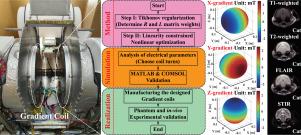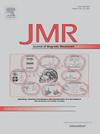Gradient coil design for a 0.23 T NICU MRI system using an improved two-step Target-Field Method with enhanced linearity and compact design
IF 1.9
3区 化学
Q3 BIOCHEMICAL RESEARCH METHODS
引用次数: 0
Abstract
This study presents an optimized gradient coil design for a miniature 0.23 T MRI system, aimed at improving absolute and relative magnetic field linearity while accommodating various gradient thicknesses. The design uses a two-step optimization approach: the first step uses Tikhonov regularization to solve a linear problem, providing a stable solution, and the second step refines the solution through nonlinear constrained optimization to further enhance field linearity. An explicit objective function for the inductance matrix of biplanar gradient coils is simplified to enhance computational efficiency. Validation through MATLAB and COMSOL finite element analysis showed excellent performance. Imaging experiments were conducted on small animals (cats and dogs, whose sizes are similar to neonates) while awaiting ethical approval for human neonatal studies. Results demonstrated that all gradient coils achieved absolute and relative linearity errors below 5%. Cubic phantom scans showed slight displacement at the edges, but the structured phantom MRI lines align precisely with the physical markers, indicating negligible geometric distortion. The shield design maintained Z-leakage fields below 5 Gauss, with eddy current compensation achieving a 90% reduction (residual X/Y-gradient 0.05%, Z-gradient 0.20%). T1 and T2-weighted images depicted clear brain structures, while FLAIR and STIR sequences effectively highlighted tissue changes. The proposed gradient coil design method significantly improves absolute and relative linearity while accommodating various gradient thicknesses, demonstrating strong resistance to interference and broad applicability. The comprehensive design-to-manufacturing process ensures optimal parameter selection, resulting in high-quality imaging across multiple MRI sequences. This design demonstrates strong potential for precise in-vivo brain imaging in further NICU applications.

采用改进的两步靶场法设计0.23 T NICU MRI系统的梯度线圈,增强了线性和紧凑的设计
本研究提出了一种优化的梯度线圈设计,用于微型0.23 T MRI系统,旨在提高绝对和相对磁场线性度,同时适应各种梯度厚度。设计采用两步优化方法:第一步采用Tikhonov正则化求解线性问题,提供稳定解,第二步通过非线性约束优化细化解,进一步增强场线性度。为了提高计算效率,对双平面梯度线圈电感矩阵的显式目标函数进行了简化。通过MATLAB和COMSOL有限元分析验证,显示出优异的性能。成像实验是在小动物(猫和狗,它们的大小与新生儿相似)上进行的,同时等待人类新生儿研究的伦理批准。结果表明,所有梯度线圈的绝对线性和相对线性误差均在5%以下。立方体幻象扫描显示边缘有轻微的位移,但结构化的幻象MRI线与物理标记精确对齐,表明几何畸变可以忽略不计。屏蔽设计将z泄漏场保持在5高斯以下,涡流补偿实现了90%的减少(残余X/ y梯度<;0.05%, z梯度<;0.20%)。T1和t2加权图像描绘了清晰的大脑结构,而FLAIR和STIR序列有效地突出了组织变化。所提出的梯度线圈设计方法在适应各种梯度厚度的同时,显著提高了绝对线性度和相对线性度,具有较强的抗干扰性和广泛的适用性。全面的设计到制造过程确保了最佳的参数选择,从而在多个MRI序列中产生高质量的成像。该设计显示了在进一步的新生儿重症监护病房应用中精确的活体脑成像的强大潜力。
本文章由计算机程序翻译,如有差异,请以英文原文为准。
求助全文
约1分钟内获得全文
求助全文
来源期刊
CiteScore
3.80
自引率
13.60%
发文量
150
审稿时长
69 days
期刊介绍:
The Journal of Magnetic Resonance presents original technical and scientific papers in all aspects of magnetic resonance, including nuclear magnetic resonance spectroscopy (NMR) of solids and liquids, electron spin/paramagnetic resonance (EPR), in vivo magnetic resonance imaging (MRI) and spectroscopy (MRS), nuclear quadrupole resonance (NQR) and magnetic resonance phenomena at nearly zero fields or in combination with optics. The Journal''s main aims include deepening the physical principles underlying all these spectroscopies, publishing significant theoretical and experimental results leading to spectral and spatial progress in these areas, and opening new MR-based applications in chemistry, biology and medicine. The Journal also seeks descriptions of novel apparatuses, new experimental protocols, and new procedures of data analysis and interpretation - including computational and quantum-mechanical methods - capable of advancing MR spectroscopy and imaging.

 求助内容:
求助内容: 应助结果提醒方式:
应助结果提醒方式:


